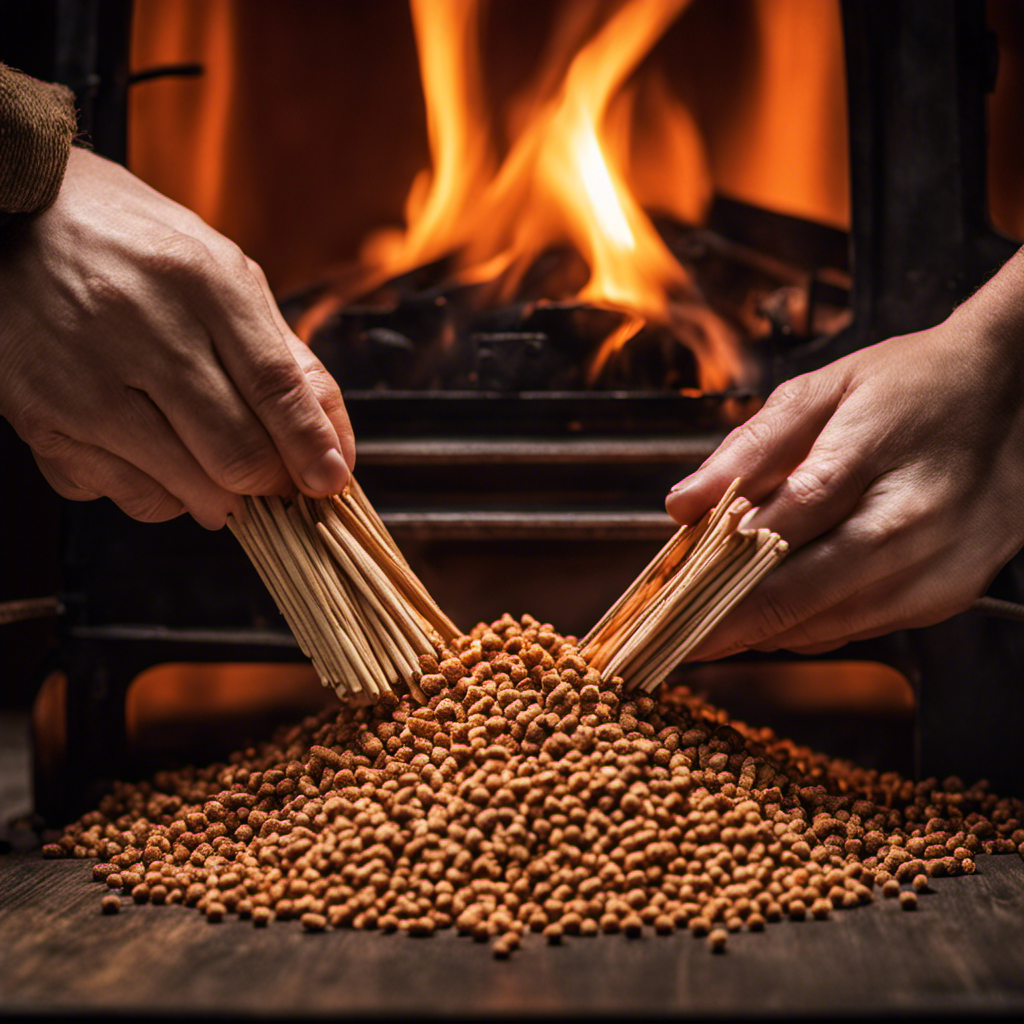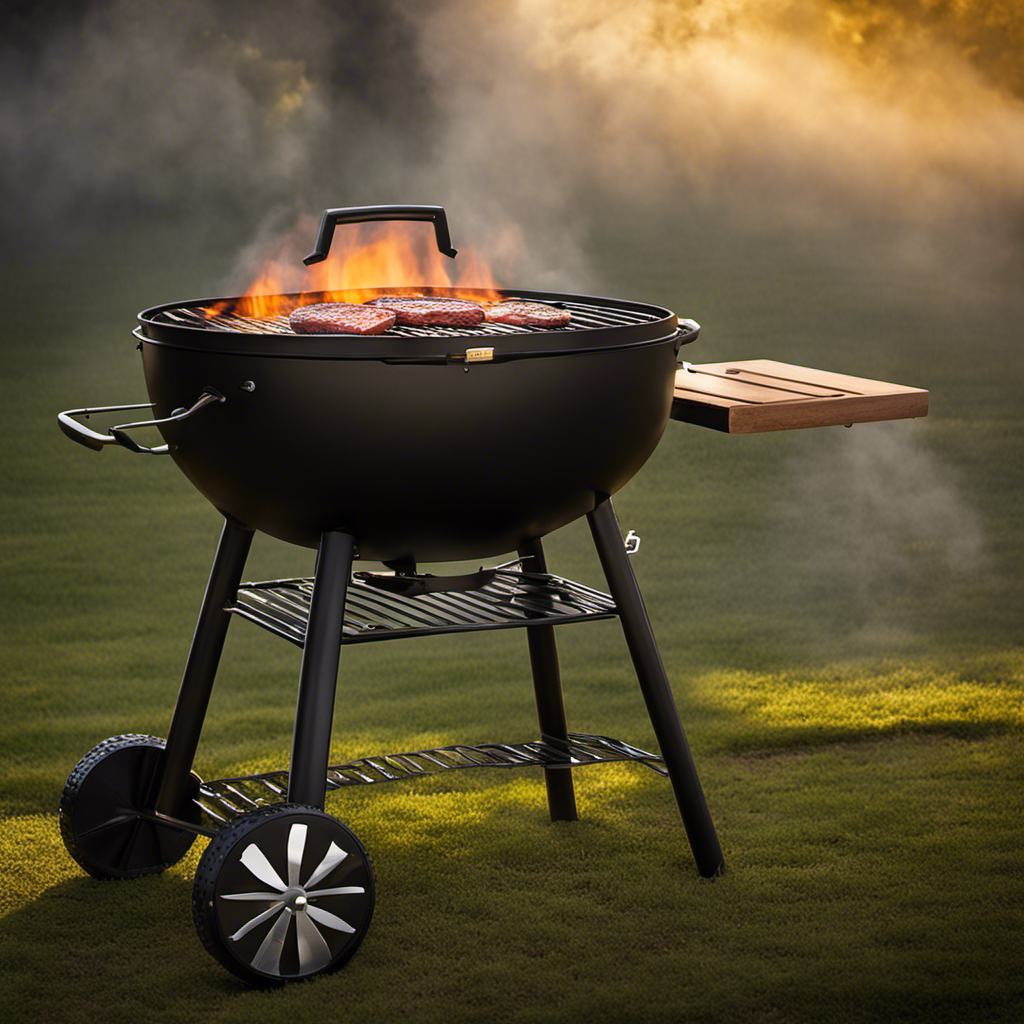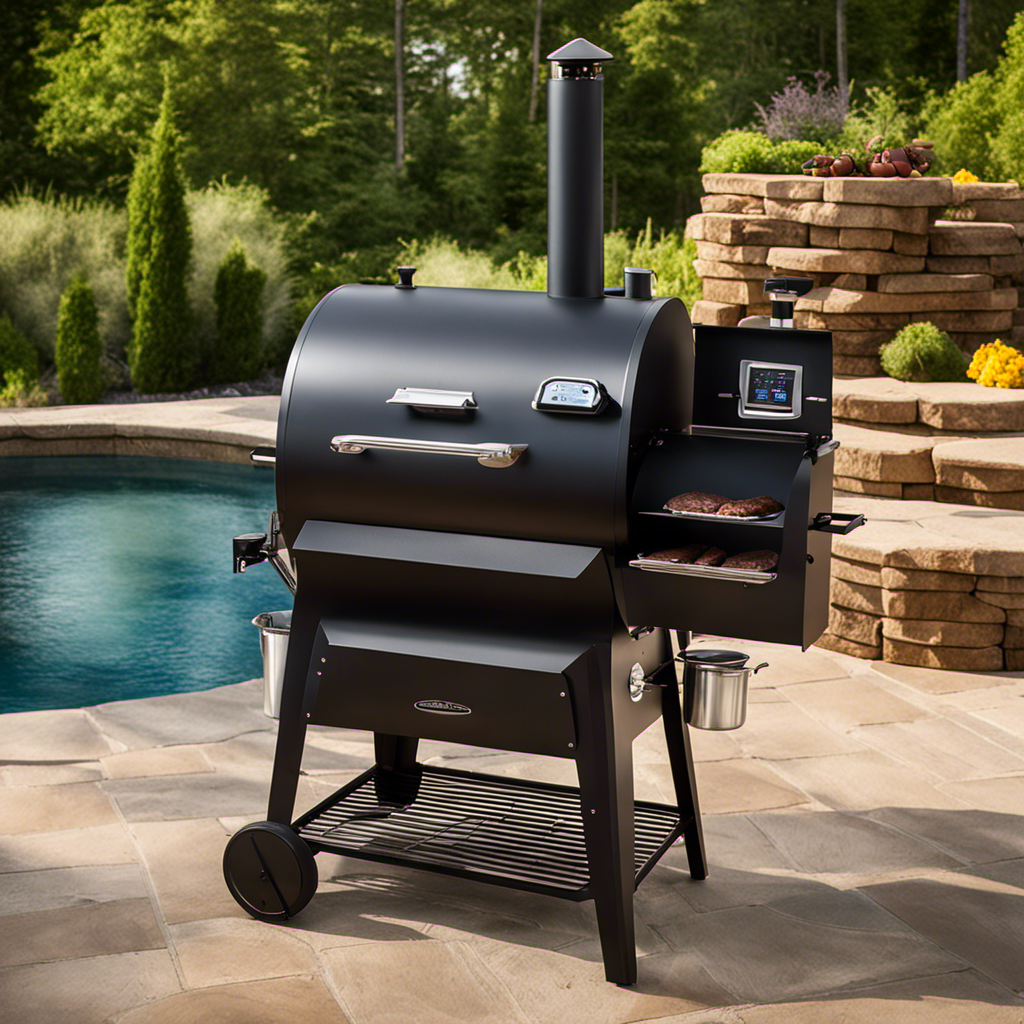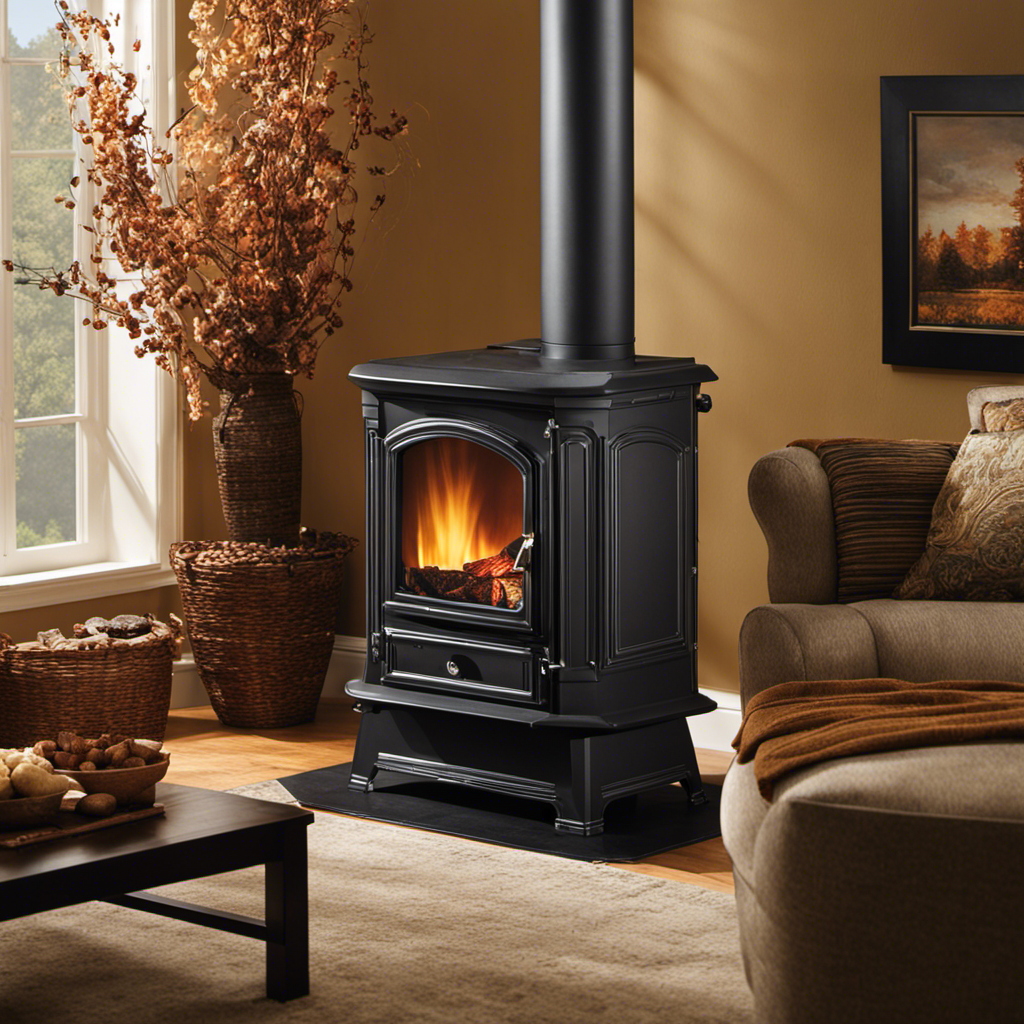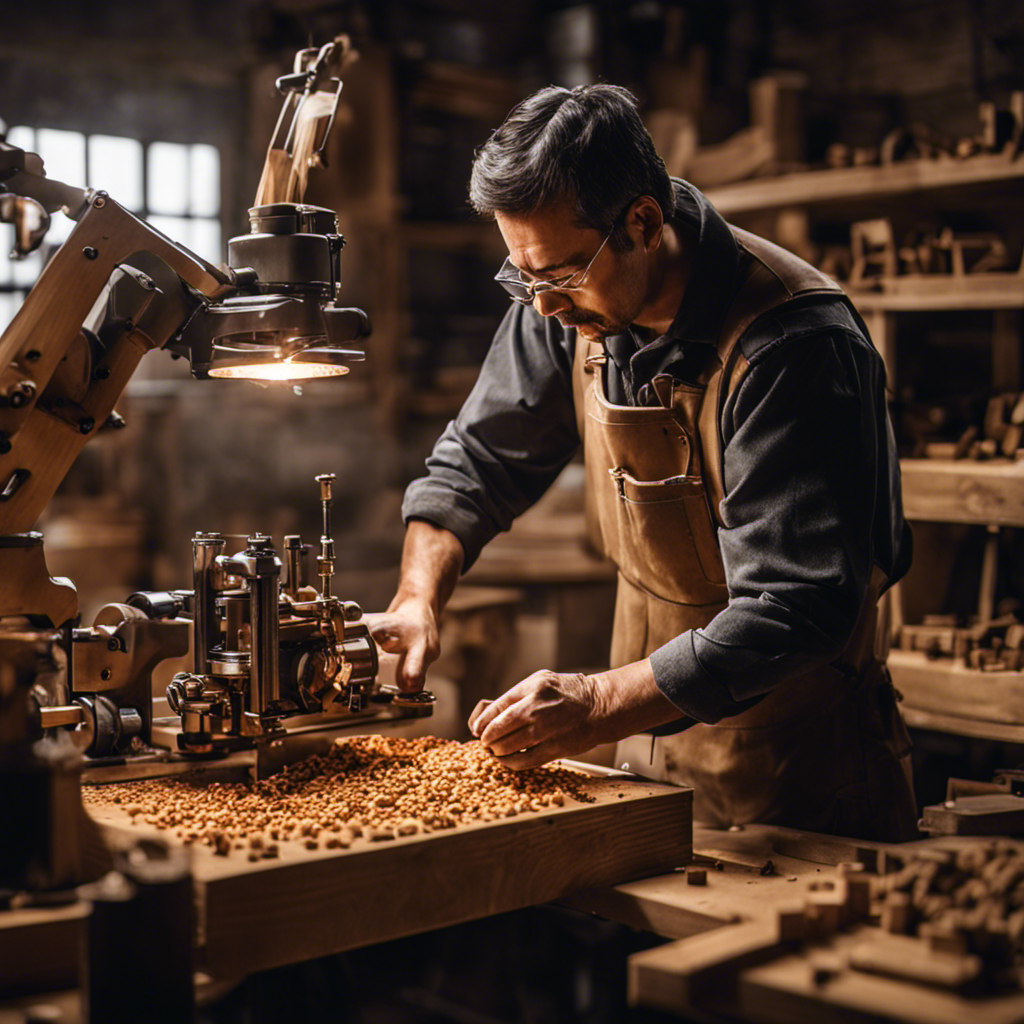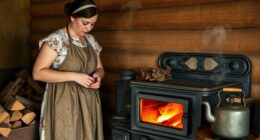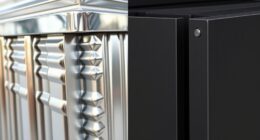As a homeowner who values the cozy heat and eco-friendly benefits of a wood pellet stove, I understand the importance of knowing the proper method to start it up.
In this informative article, I will guide you through the necessary steps to get your wood pellet stove up and running efficiently.
From selecting the right wood pellets to maintaining a clean burn, I’ll provide you with detailed instructions and troubleshooting tips to ensure a safe and successful start every time.
Let’s dive in and unlock the secrets to starting your wood pellet stove with confidence.
Key Takeaways
- Wood pellet stoves are highly efficient in heat production and fuel usage, making them a sustainable and cost-effective heating option.
- Selecting the right wood pellets, such as hardwood pellets for longer burn time and higher heat output or blended pellets for a balanced burn, is crucial for optimal stove performance.
- Proper preparation and loading techniques, including cleaning the stove and ensuring a clean and dry hopper, are essential for efficient and safe operation.
- Igniting and adjusting the stove, such as using a fire starter and adjusting airflow, require proper techniques and troubleshooting to ensure a successful start and efficient combustion.
Understanding the Basics of Wood Pellet Stoves
Understanding the basics of wood pellet stoves can help you start and maintain them properly. These stoves are highly efficient in terms of both heat production and fuel usage. The key to their efficiency lies in the design and operation of the stove.
Unlike traditional wood-burning stoves, wood pellet stoves use compressed wood pellets as the fuel source. These pellets are made from waste wood products and are highly efficient, producing a high level of heat with minimal emissions. The benefits of using wood pellets are numerous. They are a renewable energy source, reducing reliance on fossil fuels. They also burn cleaner, emitting fewer pollutants into the air.
Selecting the Right Wood Pellets for Your Stove
To ensure optimal performance, you’ll want to pick the right type of wood pellets for your stove. When choosing sustainable fuel for your wood pellet stove, it’s important to consider the different types of pellets available. Let’s compare some common pellet types in the table below:
| Pellet Type | Description |
|---|---|
| Hardwood | Made from dense, hardwood fibers, these pellets produce a longer burn time and higher heat output. They are ideal for colder climates or larger spaces. |
| Softwood | Made from softwood fibers, these pellets ignite quickly and have a high heat output. They are suitable for smaller spaces or milder climates. |
| Blended | Blended pellets combine hardwood and softwood fibers to provide a balance of burn time and heat output. They are versatile and suitable for most heating needs. |
| Premium | Premium pellets are manufactured using high-quality materials and have low ash content. They provide efficient and clean burning, making them a popular choice. |
| Standard | Standard pellets are budget-friendly options with moderate burn time and heat output. They are suitable for occasional use or as a backup fuel source. |
Preparing Your Stove for Startup
Before firing up your stove, it’s crucial to ensure that it is properly prepared for startup. Follow these steps to troubleshoot common issues and take safety precautions for operating your wood pellet stove:
-
Clean the stove: Remove any ash or debris from the burn pot, ash pan, and venting system. This prevents blockages and ensures proper airflow.
-
Check the exhaust system: Inspect the chimney and venting pipes for any obstructions or damage. Clear any debris or nests that may have accumulated.
-
Test the ignition system: Make sure the igniter is working properly and producing a spark. If not, it may need to be replaced.
By following these steps, you can ensure a smooth startup and prevent potential issues with your wood pellet stove.
Now, let’s move on to loading the wood pellets into the stove.
Loading the wood pellets into the stove is the next crucial step in getting your wood pellet stove up and running.
Loading the Wood Pellets Into the Stove
Now that you’re ready to get your stove up and running, it’s time to load those wood pellets and start enjoying the warmth.
Proper loading techniques are essential for efficient and safe operation of your wood pellet stove. To begin, make sure you have a clean and dry hopper to prevent any moisture from affecting the pellets. Open the hopper lid and carefully pour the pellets into the designated area, avoiding overfilling.
It’s important to avoid any spillage or blockage in the loading chute, as this can lead to feeding issues. If you encounter any problems, such as pellets not feeding properly, check for any obstructions and ensure the loading chute is clear.
Once the pellets are loaded, you’re ready to move on to the next phase: igniting the wood pellets.
Transition: Now that the wood pellets are loaded, we can move on to igniting them and starting the fire.
Igniting the Wood Pellets
Once the fire is lit, it’s important to maintain proper air flow to ensure a steady burn. Here are some igniting techniques and troubleshooting tips to help you get your wood pellet stove started:
-
Use a fire starter: Place a small amount of kindling or newspaper in the firebox and ignite it with a fire starter. This will help create a base of hot coals for the pellets to catch fire more easily.
-
Adjust the damper: Make sure the damper is fully open to allow for maximum airflow. This will help the fire to ignite and burn efficiently.
-
Clean the burn pot: If the pellets are not igniting properly, check if the burn pot is clean. Remove any ash or debris that may be blocking the airflow and preventing the pellets from catching fire.
By following these igniting techniques and troubleshooting tips, you can ensure a successful start to your wood pellet stove.
Now, let’s move on to adjusting the airflow for optimal combustion.
Adjusting the Airflow for Optimal Combustion
When it comes to achieving efficient combustion in a wood pellet stove, one of the key factors to consider is the importance of airflow.
Proper airflow is crucial for ensuring that the wood pellets burn evenly and produce maximum heat output.
Without adequate airflow, the combustion process can be compromised, leading to incomplete burning and a decrease in efficiency.
In this discussion, we will explore the significance of airflow in achieving efficient combustion and how to adjust it for optimal performance.
Importance of Airflow
Proper airflow is crucial for efficient operation of your wood pellet stove. Maintaining good airflow not only ensures that your stove performs optimally, but it also offers several other benefits. Here are three reasons why airflow is of utmost importance in your wood pellet stove:
-
Enhanced Combustion: Adequate airflow allows for complete combustion of the wood pellets, resulting in a cleaner and more efficient burn. This leads to increased heat output and reduced emissions.
-
Improved Efficiency: With proper airflow, your stove can achieve higher levels of efficiency, meaning it can generate more heat using less fuel. This not only saves you money but also reduces your impact on the environment.
-
Reduced Maintenance: Good airflow helps to prevent the buildup of creosote, a flammable substance that can accumulate in the stove and chimney. By reducing creosote formation, you can minimize the risk of chimney fires and prolong the lifespan of your stove.
Achieving Efficient Combustion
To achieve efficient combustion in your wood pellet stove, it’s important to understand the factors that influence the quality of the burn. Maximizing efficiency and reducing emissions are key goals in achieving optimal combustion.
One important factor is the quality of the pellets themselves. High-quality pellets are dense and have low moisture content, ensuring a clean and efficient burn.
Another factor to consider is the air-to-fuel ratio. It’s important to adjust the airflow to provide enough oxygen for complete combustion, without excessive smoke or soot.
Additionally, regular cleaning and maintenance of the stove, including cleaning the burn pot and ash pan, can help maintain efficient combustion.
By understanding and controlling these factors, you can maximize efficiency and reduce emissions in your wood pellet stove, creating a more environmentally friendly heating option.
Moving on to monitoring and maintaining the burn…
Monitoring and Maintaining the Burn
It’s important to regularly check the burn pot and remove any ash buildup. This ensures that your wood pellet stove operates at optimal efficiency. Here are three reasons why monitoring and maintaining the burn is crucial:
-
Increased burn temperature: By clearing out ash and debris, you allow for better airflow and combustion, resulting in a higher burn temperature. This means more heat for your home and improved fuel efficiency.
-
Enhanced fuel efficiency: When the burn pot is clean, the pellets can burn more efficiently, maximizing their energy output. This not only saves you money on fuel costs but also reduces the environmental impact of your stove.
-
Prolonged stove lifespan: Regular maintenance prevents excessive wear and tear on the burn pot and other components. By taking care of your wood pellet stove, you ensure its longevity and reliable performance for years to come.
By properly monitoring and maintaining the burn, you can optimize your wood pellet stove’s performance and efficiency.
Now, let’s move on to cleaning and maintaining your wood pellet stove without further ado.
Cleaning and Maintaining Your Wood Pellet Stove
When it comes to cleaning and maintaining your wood pellet stove, there are two key points to keep in mind: proper cleaning techniques and the importance of a maintenance schedule.
Proper cleaning techniques ensure that your stove operates efficiently and safely. It is crucial to follow a regular maintenance schedule to prevent any potential issues and extend the lifespan of your stove.
Proper Cleaning Techniques
Cleaning the wood pellet stove regularly ensures efficient and safe operation. Here are the proper techniques to keep your stove in top condition:
-
Use the right cleaning tools: A soft brush, a vacuum cleaner with a brush attachment, and a small ash shovel are essential for cleaning a wood pellet stove. These tools will help you remove ash, dust, and debris without causing any damage to the stove.
-
Clean the stove after every use: It is recommended to clean the stove after each use to prevent the accumulation of ash and debris. This will help maintain optimal performance and prevent potential hazards.
-
Schedule a deep cleaning: Apart from regular cleaning, it is crucial to schedule a deep cleaning at least once a year. This involves disassembling the stove, cleaning each part thoroughly, and checking for any signs of wear or damage.
By following these cleaning techniques, you can ensure that your wood pellet stove operates efficiently and safely.
Now, let’s discuss the importance of a maintenance schedule in keeping your stove in peak condition.
Maintenance Schedule Importance
To keep your stove in peak condition, you should establish a regular maintenance schedule. Regular cleaning is of utmost importance to ensure the efficiency and longevity of your wood pellet stove. By adhering to a maintenance schedule, you can prevent common issues that may arise from neglect or improper care.
One of the most common maintenance mistakes is failing to clean the stove on a regular basis. Over time, a build-up of ash and debris can hinder the stove’s performance and potentially damage its components. Additionally, neglecting to clean the stove’s venting system can lead to blockages and poor ventilation, which can affect the stove’s ability to burn efficiently.
By properly cleaning and maintaining your stove, you can avoid these common pitfalls and ensure it functions optimally.
Now, let’s move on to troubleshooting common startup issues…
Troubleshooting Common Startup Issues
If you’re having trouble starting your wood pellet stove, check for any blockages in the fuel supply line. This is a common issue that can prevent the stove from igniting.
Here are a few troubleshooting tips to help you get your pellet stove up and running:
-
Ensure that the fuel hopper is filled with pellets. Sometimes, an empty hopper can cause startup problems.
-
Check the power supply to make sure the stove is receiving electricity. A tripped circuit breaker or a faulty outlet can be the culprit.
-
Clean the stove thoroughly, especially the burn pot and the exhaust vent. A buildup of ash and debris can hinder the stove’s performance.
By following these troubleshooting steps, you should be able to identify and resolve most startup issues with your wood pellet stove.
Now, let’s move on to discussing the safety precautions for operating a wood pellet stove.
Safety Precautions for Operating a Wood Pellet Stove
Ensure the area around your stove is clear of any flammable materials or objects that could pose a fire hazard. It is crucial to prioritize safety when operating a wood pellet stove.
One of the main risks associated with stoves is the potential for carbon monoxide poisoning. To prevent this, make sure your stove is properly vented and install carbon monoxide detectors in your home.
Additionally, regularly inspect and clean your stove to minimize the risk of a fire. Keep flammable items, such as curtains or furniture, at a safe distance from the stove.
It is also important to never leave the stove unattended while it is in use. By taking these precautions, you can greatly reduce the risk of both carbon monoxide poisoning and house fires.
Can the process of starting a wood pellet stove be applied to setting up a manufacturing plant?
Starting a wood pellet manufacturing plant involves similar processes to starting a wood pellet stove. Both require proper planning, sourcing of materials, setting up machinery, and ensuring safety measures are in place. It’s essential to follow industry regulations and guidelines to successfully establish a wood pellet manufacturing plant.
Frequently Asked Questions
How Often Should I Clean and Maintain My Wood Pellet Stove?
I clean and maintain my wood pellet stove regularly to ensure optimal performance. Cleaning frequency depends on usage, but generally, it’s recommended to clean the stove every 1-2 weeks. Regular maintenance tips include checking and cleaning the burn pot, ash pan, and exhaust vent.
Can I Use Any Type of Wood Pellets in My Stove, or Are There Specific Requirements?
There are specific requirements for the types of wood pellets suitable for wood pellet stoves. It’s important to use high-quality pellets that are made from hardwood and have a low moisture content. Properly storing wood pellets is also crucial for maintaining their quality.
What Safety Precautions Should I Take When Operating a Wood Pellet Stove?
When operating a wood pellet stove, it’s crucial to prioritize safety. Here are some precautionary steps to consider: ensure proper ventilation, keep flammable materials away, regularly clean and maintain the stove, and never leave it unattended.
What Are Some Common Startup Issues With Wood Pellet Stoves and How Can I Troubleshoot Them?
Common causes of wood pellet stove startup issues can include a clogged fuel delivery system, insufficient airflow, or a faulty ignition system. Troubleshooting tips may involve cleaning the system, checking the air intake, and inspecting the ignition components for any malfunctions.
How Long Does It Typically Take for the Wood Pellets to Ignite and Start Producing Heat?
On average, wood pellets take about 10-15 minutes to ignite and start producing heat. This quick ignition time contributes to the overall heating efficiency of wood pellet stoves, making them a popular choice for many homeowners.
Conclusion
In conclusion, starting a wood pellet stove is a simple process that can provide warmth and comfort in your home. By understanding the basics, selecting the right pellets, and following the proper steps, you can successfully start and maintain your stove.
It’s important to note that wood pellet stoves are an eco-friendly alternative to traditional heating methods, reducing carbon emissions by up to 90%. This statistic highlights the positive impact that using a wood pellet stove can have on the environment, making it a compelling choice for eco-conscious individuals.
So go ahead, start your wood pellet stove and enjoy the benefits of efficient and sustainable heating.
Logan’s affair with adventure began in childhood. He hailed from a small town where vast forests bordered one side and endless shores stretched on the other. His days were spent exploring uncharted woods, climbing tall trees, or listening to the tales of old sailors. This early immersion in a world brimming with stories and mysteries became the foundation of his passion for writing.

